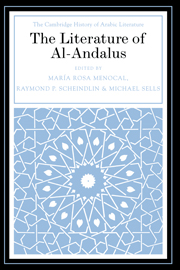7 - The muwashshah
from PART II - THE SHAPES OF LITERATURE
Published online by Cambridge University Press: 28 May 2012
Summary
THE GENRE
Of all the forms known to Arabic literature in al-Andalus, only strophic poetry is known to have originated on the peninsula. Despite certain characteristic thematic features, the Andalusian qasida and maqama remained principally products of the Muslim East, but strophic poetry is a quintessentially Andalusian creation and the most complete literary embodiment of the multiethnic and multilingual fabric of Andalusian society. The pride that Andalusians and Maghribis took in these genres is echoed well into the fourteenth century by Ibn Khaldūn, whose survey of Arabic literature culminates in an account of Andalusian strophic poetry. In both its varieties, the muwashshah – the prosodically more complicated form, employing classical language in all but its concluding couplet – and the zajal – which is simpler in form and vernacular throughout – Andalusian strophic poetry is indeed the most distinguished contribution of the Muslim West to the history of Arabic poetry, and its forms are most explicitly involved with the universe of incipient Romance lyrics.
But which form came first? The muwashshah – of which the earliest examples to have reached us date from the eleventh century – or the zajal – which appears as a literary form a little more than a hundred years later? Was one derived from the other? Or were these cognate forms both derived from an earlier type, the traces of which have vanished? Are those modern critics who follow Ibn Khaldūn right in considering the zajal to be the popularization and hybridization of the muwashshah? Or are those critics who see the muwashshah as the product of the literary elevation of the zajal correct? These questions are treated briefly below, in the survey of scholarship. Our present discussion is limited to the muwashshah.
- Type
- Chapter
- Information
- The Literature of Al-Andalus , pp. 163 - 189Publisher: Cambridge University PressPrint publication year: 2000
References
- 3
- Cited by



